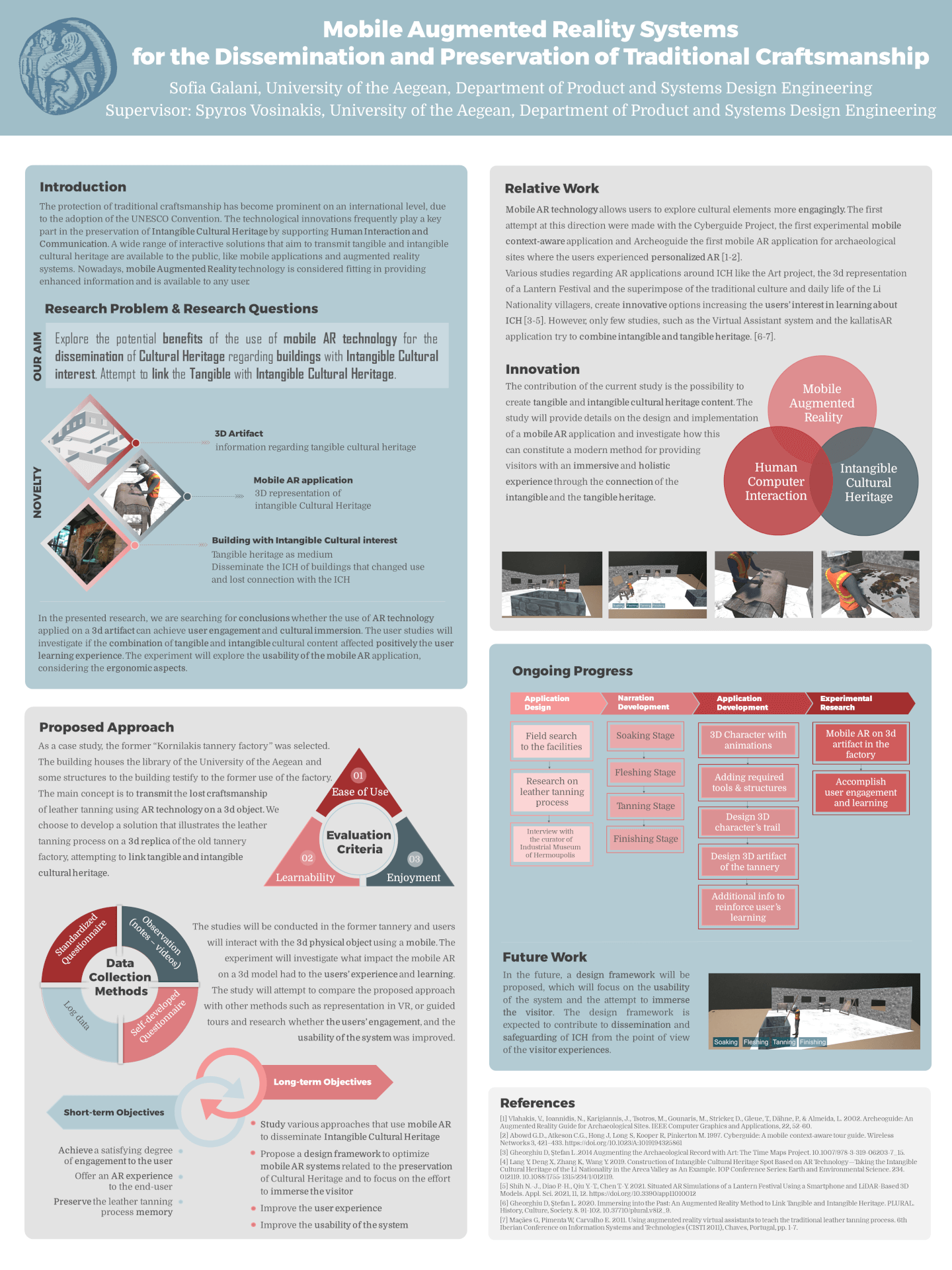The protection of traditional craftsmanship has become prominent on an international level, due to the adoption of the UNESCO Convention. Technological innovations frequently play a key part in the preservation of intangible cultural heritage by supporting human interaction and communication. A wide range of interactive solutions that aim to transmit tangible and intangible cultural heritage is available to the public, like mobile applications and augmented reality systems. Nowadays, mobile augmented reality technology is considered fitting in providing enhanced information and is available to any user.
Research problem & Research questions
The aim of this research is to explore the potential benefits of the use of mobile AR technology for the dissemination of cultural heritage regarding buildings with intangible cultural interest. Intangible cultural heritage consists of practices and a way of presenting them is with animated characters. Often, the dissemination of ICH relates to the narration of a practice and since any practice occurs to a place, linking the tangible with intangible cultural heritage creates a more complete attempt.
The novelty of this research is the application of mobile AR on a physical artifact which represents tangible heritage, with data that depict the ICH. This approach offers through a tangible procedure the possibility to overview the process and easily observe from various sides. A physical 3d model will provide information about important elements of the building and the 3d representation will present the craftsmanship. In brief, this research, using the tangible heritage as medium, will attempt to disseminate the ICH in cases where the original buildings have changed use and the connection with the ICH is lost.
In the presented research, we are searching for conclusions whether the use of AR technology applied on a 3d model can achieve user engagement and cultural immersion. The user studies will investigate if the combination of tangible and intangible cultural content affected positively the user learning experience. The experiment will explore the usability of the mobile AR application, considering the ergonomic aspects.
Relative work
Mobile AR technology allows users to explore cultural elements more engagingly. Various studies regarding AR applications around ICH create innovative options increasing the users’ interest in learning about ICH. However, only few try to combine intangible and tangible heritage.
The contribution of the current study is the possibility to create tangible and intangible cultural heritage content. The study will provide details on the design and implementation of a mobile AR application and investigate how this can constitute a modern method for providing visitors with an immersive and holistic experience through the connection of the intangible and the tangible heritage.
Proposed approach
As a case study, the former “Kornilakis tannery factory” was selected. The building houses the library of the University of the Aegean and some structures to the building testify to the former use of the factory. The main concept is to transmit the lost craftsmanship of leather tanning using AR technology on a 3d object. We choose to develop a solution that illustrates the leather tanning process on a 3d replica of the old tannery factory. attempting to link tangible and intangible heritage.
The studies will be conducted in the former tannery and users will interact with the 3d physical object using a mobile. The experiment will investigate what impact the mobile AR on a 3d model had to the users’ experience and learning. The study will attempt to compare the proposed approach with other methods such as representation in VR, or guided tours and research whether the users’ engagement, and the usability of the system was improved.
The short-term goals of this study are to create satisfying degree of engagement to the user, offer to the end-user an AR experience and preserve the leather tanning process memory. In the long-term, we wish to study various approaches for using mobile AR to disseminate intangible heritage and probably propose a design framework to optimize that kind of systems related to the preservation of cultural heritage and more specifically in improving the user experience. The design framework will focus on improving the usability of the system and the effort to immerse the visitor.
Ongoing Progress & Future Work
Το design the application, we did field search to the facilities, we studied the leather tanning process, and we interviewed the curator of the Industrial Museum of Hermoupolis. Afterwards, the narrative scenario was developed.
For the application development, a detailed 3d character was enriched with the appropriate animations and the required tools and structures were inserted into the scene. The latter was the design of the character’s trail and the 3d artifact of the tannery. Finally, additional information was imported to reinforce the user immersion and learning.
Presently, experimental research using the mobile AR application will be conducted in the tanning factory to rise conclusions whether user engagement and learning is accomplished. In the future, a design framework will be proposed, which will focus on the usability of the system and the attempt to immerse the visitor. The design framework is expected to contribute to dissemination and safeguarding of ICH from the point of view of the visitor experiences.

